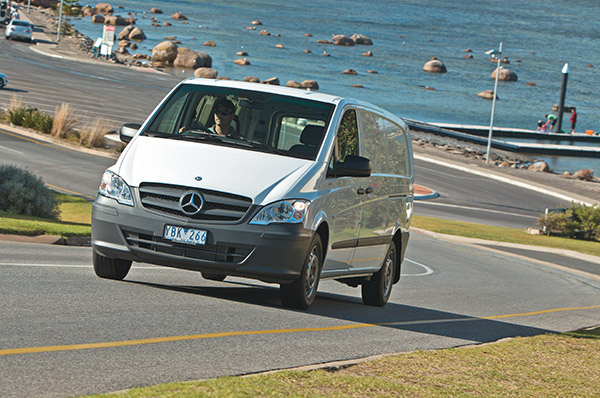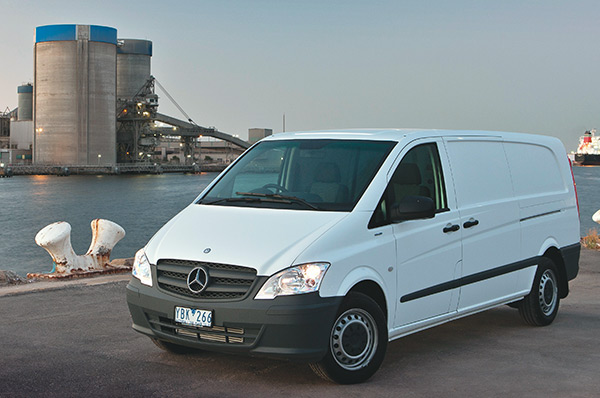With Mercedes-Benz now top dog in the light-duty van segment, the popular Vito came in for a makeover and looks set to continue the market dominance established by its predecessor. Gary Worrall reports.
With the previous iteration the most successful ever for Mercedes-Benz in Australia, the latest Vito looks to build on that success with redesign of critical engineering components as well as a facelift to visually integrate the van range into the Mercedes-Benz passenger car line-up.
Many of the Vito’s external lines are familiar, particularly when viewed in profile. The semi-bonneted nose still leads the way and flows back into the usual ‘long box’ cargo area.
The biggest change is around the headlight and grille. The Vito now sports twin horizontal bars incorporating the traditional three-pointed star, while the headlights wrap around into the top of the front guards, allowing a single indicator to be seen from both in front and the side. The repeater signal has been moved to between the wheelarch and the door.
A prominent swage line runs from the outer edge of the grille insert up the bonnet, creating a central ‘power bulge’ before flattening into the bonnet as it nears the A-pillar.
Another line extends rearward from the headlight assembly into the sliding doors and reappears in the rear quarter as a high waistline under the window panel. Lower down, a hipline runs from the front doors into the sliding door channel.
A small gap between the headlights and the bumper allows for the fitment of a washer for the optional bi-xenon lamps. A wide mouth under the bumper allows for air to be drawn in and across the lower part of the engine and air-conditioning radiators.
Engine
The 2011 Vito is available as either short- or long-wheelbase, with four engine ratings: the 110CDI, 113CDI, 116CDI and 122CDI.
With the exception of the V6 122CDI, all models use the new OM 651 four-cylinder powerplant, producing 70 (110CDI), 100 (113CDI) or 120kW (116CDI).
The V6 122CDI (165kW) has an abundant power and torque (440Nm) ensuring the range-topping version does not suffer by comparison with its stablemates.
Transmission
Also with the exception of the V6 122CDI, all models feature either a six-speed manual ECO Gear transmission or an optional five-speed automatic.
The V6 122CDI is available with the automatic transmission as standard.
Cab and Controls
So while the exterior is a refinement of the existing package, the interior is a blend of old and new. There are just enough items unchanged to make the driver comfortable, yet there is plenty of new technology tucked inside.
While the dash retains a simple layout of speedo and tacho flanked by ancillary gauges for water temperature and fuel level, there is also a multi-function display providing a selection of screens for the driver.
Controlled by buttons on the steering wheel, the display gives information such as road speed, ambient temperature, and also speed settings for both the cruise control and also the speed limiter.
The steering wheel also has buttons for the Bluetooth telephone connection, which is fitted as standard to all but the base 110CDI.
Where previous models used rocker switches for minor functions, the new Vito replaces them with push buttons fitted in a line across the central dash area, above the upgraded AM/FM/CD stereo system.
As well as the wheel-mounted controls, the stereo is also fitted with a full keypad for the remote telephone connection.
Performance
The driving position is high and proud, with a high-backed seat atop an elevated base offering a clear field of vision to the front and sides. The seats themselves are covered in hard-wearing fabrics and offer good support for the back, shoulders and thighs.
A short initial drive shows plenty of head, shoulder and leg room for occupants, while the dash-mounted gearshift allows the driver to walk through to the passenger side in the two-seat cab configuration.
The Vito can be ordered in several seating variants: a standard ‘two-up’ van; a crew-cab seating five, two in the front and three in the rear, plus cargo space; and eight- and nine-seat wagon versions. The multi-seat vans, of course, have greatly reduced cargo space.
In addition to the standard driver and passenger airbag, the Vito can be optioned with window airbags on all versions, while the 113, 116 and 122 variants can be fitted with side thorax airbags.
As well as offering operators Euro 5 compliance, the new engines are also claimed to be the most fuel-efficient that Mercedes-Benz has offered in a van, with the 113 and 116 four-cylinder versions achieving a claimed 7.4 litres per 100km average consumption, while the 110CDI offers 7.7 litres per 100km and the V6 is rated at 8.6 litres per 100km.
Verdict
Campbell York, manager of the Mercedes-Benz Australia’s van division. says research shows buyers choose the Mercedes-Benz product as it is more than ‘tin and rubber’, citing safety and environmental concerns and quality and durability as some of the factors influencing purchase decisions.
These reasons formed the basis of the ‘Formula Won’ campaign underpinning the new model range, which saw the range reduced from 20 models to eight base versions, the new Euro 5 engines and new transmissions, a new chassis, reduced pricing and increased levels of standard equipment.
Specifications
Engine: 2.2-litre four-cylinder turbodiesel; V6 turbo-diesel
Transmission: 6-speed manual; optional 5-speed auto
Power/Torque:
110CDI: 70kW/250Nm (94hp/184ft-lb)
113CDI: 100kW/310Nm (134hp/229ft-lb)
116CDI: 120kW/360Nm (161hp/265ft-lb)
122CDI: 165kW/440Nm (221hp/ 324ft-lb)
GVM: 3,050kg
Find Mercedes-Benz Vito trucks for sale.









